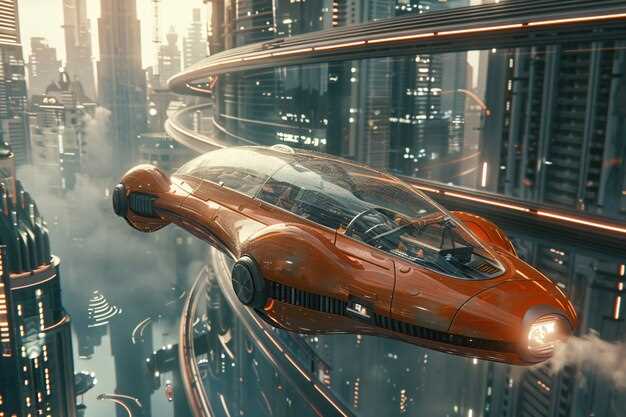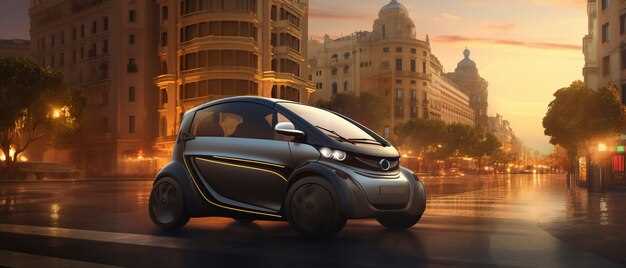Electric cars are redefining muscle car performance. With instant torque delivery and advanced technology, electric muscle cars deliver exhilarating acceleration that rivals traditional V8 engines. Brands like Ford and Chevrolet are already making waves with their electric models, showcasing impressive power and speed.
Consider the Ford Mustang Mach-E, which produces up to 480 horsepower and 634 lb-ft of torque. This performance sets a new standard for electric vehicles, demonstrating that electrification does not sacrifice excitement. Similarly, the Chevrolet Camaro’s electric counterpart is on the horizon, promising thrilling performance metrics that appeal to muscle car enthusiasts.
Battery technology plays a crucial role in this evolution. The latest advancements have led to lighter, more energy-dense batteries, enhancing not only range but also performance. As research continues, expect even more powerful electric muscle cars that deliver both speed and endurance on the track, ensuring they hold their ground against their gas-powered predecessors.
Environmental considerations drive this shift as well. With growing concerns about emissions, manufacturers are focusing on electric options to meet sustainability goals. Consumers increasingly prioritize greener alternatives, making electric performance vehicles appealing from both a performance and ethical standpoint.
Electric muscle cars represent a thrilling union of power and innovation. The future of performance lies in these silent yet ferocious machines, ready to change the definition of what a muscle car can be.
Comparing Acceleration: Electric vs. Traditional Engines
Electric vehicles (EVs) consistently outperform traditional combustion engines in acceleration tests. The instant torque delivery from electric motors translates to quicker starts. For instance, a Tesla Model S can reach 60 mph in as little as 2.4 seconds, while a classic muscle car like the Dodge Challenger R/T takes about 4.5 seconds with a V8 engine.
Track results highlight the efficiency of EVs. With fewer moving parts, electric drivetrains minimize energy loss, enabling them to sustain high-performance levels through longer durations. High-performance electric vehicles often achieve consistent lap times due to stable power delivery and reduced heat build-up.
Transmission systems in traditional cars require time to shift gears, which can slow down acceleration. In contrast, electric motors offer a single-speed transmission, providing seamless power from start to finish. This design allows EVs to maintain momentum without the lag encountered in multi-speed systems.
Handling also plays a key role in acceleration. Lower center of gravity in EVs leads to improved traction during rapid starts. Muscle cars, despite their raw power, sometimes struggle with traction due to weight distribution and rear-wheel drive setups.
While traditional engines may excel in auditory appeal and nostalgia, the acceleration metrics favor electric performance in drag racing scenarios. As technology advances, the gap between these two types of vehicles may continue to widen, suggesting that electric alternatives could dominate the muscle car performance scene.
The Role of Battery Technology in Muscle Car Enhancements
Advancements in battery technology directly enhance muscle car performance by increasing power and efficiency. Modern lithium-ion batteries deliver higher energy densities, allowing for lighter battery packs that don’t compromise vehicle weight. This crucial factor contributes to improved acceleration and handling.
Fast charging capabilities also matter. With developments such as solid-state batteries, charging times can significantly decrease, leading to more convenient usage without extended downtime. This allows muscle car enthusiasts to enjoy performance boosts without lengthy interruptions.
Battery thermal management systems help to maintain optimal operating temperatures, enhancing safety and overall battery longevity. Efficient cooling mechanisms prevent overheating, which can diminish performance during high-intensity driving situations.
Battery modularity plays a key role in customization. Muscle car developers can now design power systems specific to their models, allowing for tailored performance attributes such as increased torque or extended range. This ability to fine-tune battery configuration directly impacts the driving experience.
High-performance batteries also enable regenerative braking systems, which capture kinetic energy during acceleration. This energy can be stored and reused, contributing to overall efficiency and offering drivers an enhanced sense of control.
Incorporating advanced battery technologies ensures that muscle cars not only maintain their iconic power but also embrace new levels of performance in an eco-conscious manner. These innovations create exciting possibilities for the future of muscle cars, where speed and sustainability can coexist.
Noise and Vibration: How Electric Drive Changes Muscle Car Experience
Electric muscle cars deliver impressive torque instantly, transforming acceleration dynamics. Without a traditional combustion engine, the experience shifts to a silent but powerful launch. This changes the thrill often associated with muscle cars. Sounds like engine roars and exhaust growls give way to a quieter, almost eerie experience.
While some enthusiasts might miss the traditional engine noise, others appreciate the subtle sound profile electric drivetrains offer. Many manufacturers integrate artificial sound systems, simulating the growl of muscle cars to maintain an engaging auditory experience. Choosing models with customizable sound options allows drivers to tailor their experience, reflecting personal preferences.
The reduction of vibration enhances comfort levels. Electric motors create less mechanical vibration, eliminating some of the jolts associated with gas-powered engines. This provides a smoother ride, especially noticeable during extended drives on highways. Advanced materials in construction further minimize vibrations, allowing for a refined driving experience.
Weight distribution significantly shifts with electric drivetrains, lowering the center of gravity. This redesign impacts handling characteristics, contributing to stability and responsiveness in corners. The setup allows for a different muscle car performance experience, one that relies less on brute force and more on precision driving.
To enhance the electric muscle car experience, consider options for adjustable suspension systems. These allow tuning based on driving preferences, further refining handling and comfort on various terrains. As engineers continue to innovate in electric vehicle technology, expect exciting advancements in noise and vibration management.
Cost Analysis: Maintenance and Ownership of Electric Muscle Cars
Consider investing in electric muscle cars for lower maintenance and ownership costs. Battery electric vehicles (BEVs) typically have fewer moving parts than traditional combustion engines, which translates to reduced maintenance needs.
- Maintenance Costs:
- Regular service for electric vehicles (EVs) often excludes oil changes and reduces the frequency of brake replacements due to regenerative braking.
- Instead of routine engine maintenance, focus on checking the battery system and software updates, which are usually less costly.
- Battery Replacement:
- Batteries can represent a significant expense, typically ranging from $5,000 to $15,000, although many manufacturers provide warranties covering potential issues for 8 years or more.
- Monitor battery health through software to avoid premature replacements; charging habits can prolong battery life.
Consider charging infrastructure costs. Installing a home charging station may range from $500 to $2,000, depending on electrical requirements. However, public charging options create flexibility and reduce long-term expenses if installed correctly.
- Insurance Rates:
- Insurance for electric muscle cars might be slightly higher due to the value of the vehicle and battery but can decrease with the increasing popularity of these models.
- Research multiple providers to find competitive rates, as some insurers offer discounts for EV owners.
- Fuel Savings:
- Charging costs often yield substantial fuel savings compared to gasoline; electricity is usually cheaper per mile.
- Utilize home solar installations to charge vehicles, potentially lowering costs even more.
Include potential resale value in your analysis. As demand for electric vehicles grows, their resale values are projected to stabilize or even appreciate. Keeping your vehicle in good condition enhances its future worth.
These factors combined highlight that while initial investments in electric muscle cars seem high, long-term savings on maintenance, fuel, and insurance create an appealing total cost of ownership. Make informed decisions to enjoy the thrill of electric muscle performance without breaking the bank.
Performance Regulations: Are Electric Cars Fitting into Muscle Car Culture?
Integrating electric cars into muscle car culture requires a shift in how performance is defined and regulated. Current regulations often focus on traditional metrics like horsepower and engine displacement. Electric cars, however, thrive on torque and instantaneous power delivery, which can redefine performance standards.
For a successful incorporation of electric vehicles into the muscle car realm, manufacturers should consider establishing new performance benchmarks. These benchmarks must evaluate acceleration, handling, and braking capabilities more relevant to electric systems. This allows electric muscle cars to compete fairly with their gas counterparts while appealing to traditional muscle car enthusiasts.
Data from recent electric muscle car models shows impressive performance metrics:
| Model | 0-60 mph (seconds) | Power (HP) | Torque (lb-ft) |
|---|---|---|---|
| Ford Mustang Mach-E 1400 | 3.8 | 1400 | 2000 |
| Dodge Charger EV | 3.5 | 800 | 650 |
| Chevrolet eCOPO | 3.0 | 700 | 600 |
These figures illustrate that electric muscle cars can match or surpass traditional models in key performance areas, proving their place within the culture. Incorporating classic design elements with modern technology will also resonate with enthusiasts, enhancing acceptance. Collaborations with iconic muscle car brands can bridge the gap between nostalgia and innovation, creating a robust electric muscle car community.
By adopting a broader view of performance and adjusting regulations accordingly, electric vehicles can thrive and redefine muscle car culture. Focusing on torque, acceleration, and driver engagement will ensure these new models not only fit in but become cherished members of the muscle car legacy.
The Future of Design: How Electric Motors Influence Muscle Car Aesthetics
Electric motors offer unique design opportunities for muscle cars. Designers can focus on aerodynamics without the constraints of traditional combustion components. For instance, the absence of a bulky engine bay allows for sleeker front profiles, enhancing visual appeal and performance efficiency.
Incorporating lightweight materials such as carbon fiber and aluminum not only reduces weight but also allows for more sculpted shapes. This shift toward lighter designs supports better handling and agility, key characteristics for modern muscle cars.
Additionally, electric drivetrains permit designers to experiment with unconventional layouts. Placing batteries low in the chassis lowers the center of gravity, improving stability. This reconfiguration opens up new possibilities for body styles and proportions, creating a fresh aesthetic distinct from classic muscle cars.
Customization options expand with electric models. Manufacturers can integrate advanced lighting systems and dynamic visual elements, allowing for personalized vehicle appearances. Innovative digital interfaces can enhance the interior, providing a futuristic yet user-friendly experience.
As charging technologies improve, the emphasis on practicality will encourage design innovations focused on usability without compromising style. Integrating charging ports discreetly and enhancing trunk space creates a blend of form and function.
Future muscle car designs will inevitably showcase a blend of classic aesthetics and modern technologies. The ability to offer thrilling performance while retaining iconic styles positions electric muscle cars as both a nod to tradition and a look into the future. Expect to see a surge in bold, innovative designs that redefine what it means to be a muscle car in the electric age.







